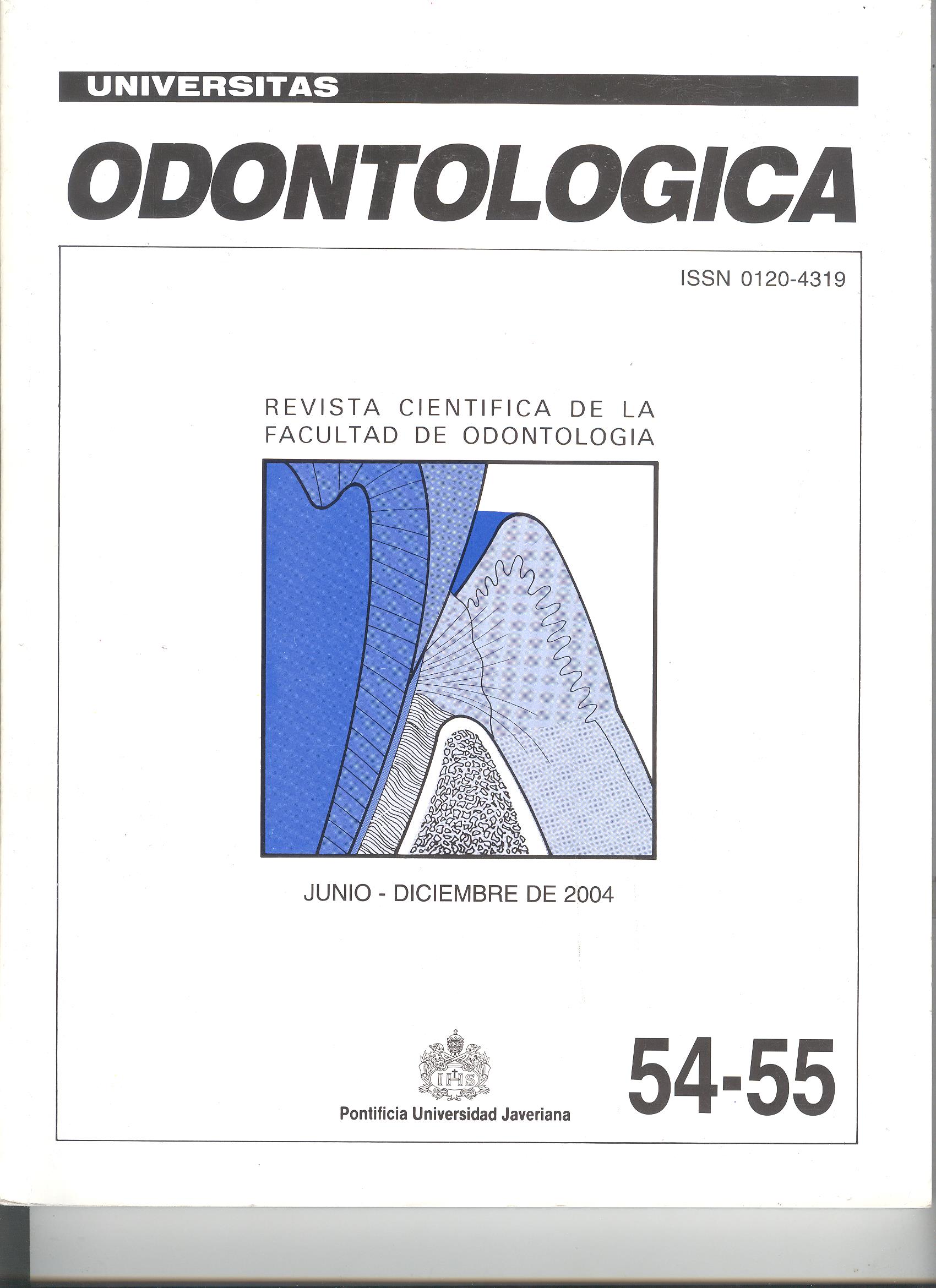Resumen
ANTECEDENTES: el Twin-Block es un aparato funcional que protruye la mandíbula y corrige la maloclusión clase II división 1. Persiste la duda de si el Twin-Block genera cambios esqueléticos verdaderos, compensaciones dentoalveolares o una combinación de estos factores. OBJETIVO: observar las diferencias entre las medidas cefalométricas de dos pacientes clase II división 1, con unas edades esqueléticas de 8 y 10 años, antes de empezar tratamiento con Twin-Block y luego de 12 meses. MÉTODOS: El estudio corresponde a un reporte de dos casos, que fueron seleccionados de manera intencional. Los criterios de inclusión fueron maloclusión clase II división 1, edad esquelética de 8-10 años, presencia de primeros molares permanentes, buenas forma de arcos e higiene oral, no tratamiento ortodóntico previo, ausencia de enfermedades sistémicas. Los criterios de exclusión fueron niños que no cumplieran con el tratamiento o hubieran decidido no continuar, radiografías defectuosas. RESULTADOS: en ambos pacientes aumentaron el tamaño y la longitud mandibular, disminuyó el resalte y se mantuvo la clase esquelética. El paciente 1 presentó compensación dentoalveolar y en el paciente 2 la vestibuloversión superior se hizo más marcada. CONCLUSIONES: pese a los estudios existentes con respecto a la actividad del Twin-Block, aún es discutible su eficacia y por tanto es necesario continuar investigando.
Thilander B, Peña L, Infante C, Parada SS, de Mayorga C. Prevalence of malocclusion and orthodontic treatment need in children and adolescents in Bogotá, Colombia. An epidemiological study related to different stages of dental development. Eur J Orthod 2001 Apr; 23(2): 153-67
Canut JA. Ortodoncia clínica y terapéutica, 2ª ed. Barcelona, España: Masson, 2000; 535-72
Tümer N, Gültan A. Comparison of the effects of monoblock and Twin-block appliances on the skeletal and dentoalveolar structures. Am J Orthod Dentofac Orthop 1999 Oct; 116(4): 460-8
Moss M. The functional matrix hypothesis revisited. 2. The role of an osseous connected cellular network. Am J Orthod Dentofac Orthop 1997 Aug; 112(2): 221-6
Moss M. The functional matrix hypothesis revisited. 4. The epigenetic antithesis and resolving synthesis; Am J Orthod Dentofac Orthop 1997 Oct; 112(4): 410-17
Harris JE, Kowalski CJ, Walker SJ. Intrafamiliar dentofacial associations for class II division 1 probands. Am J Orthod 1975 May; 67(5): 563-70
Graber T, Rakosi T, Petrovic A. Ortopedia dentofacial con aparatos funcionales, 2ª ed. Madrid, España: Harcourt, 1998; 273-303
Clark W. Tratamiento funcional con bloques gemelos – Aplicaciones en ortopedia dentofacial, 1ª ed. Madrid, España: Harcourt Brace, 1998; 13-18
Moseley HC, Horrocks EN, Welfare RR. Use of a modified twin block appliance following partial maxillectomy: Case report. Br J Orthod 1996 May; 23(2): 103-8
Baccetti T, Franchi L, Ratner L, McNamara J. Treatment timing for Twin-Block therapy. Am J Orthod Dentofac Orthop 2000 Aug; 118(2): 159- 70
Proffit W. Contemporary Orthodontics, 2nd ed. St. Louis, MO, USA: Mosby, 1986: 423-433
Woodside DG, Altuna G, Harvold E, Herbert M, Metaxas A. Primate experiments in malocclusion and bone induction. Am J Orthod 1983; 83(6): 460-8
Aggarwal P, Kharbanda OP, Mathur R, Duggal R, Parcas H. Muscle response to the Twin-Block appliance: An electromyographic study of the masseter and anterior temporal muscles. Am J Orthod Dentofac Orthop 1999 Oct; 116(4): 405-14
Del Hierro A, Forero D. Variación en el metabolismo óseo mandibular en pacientes Clase II división 1 con edad esquelética entre 96 y 120 meses tratados con Twin-Block. Trabajo de posgrado en Ortodoncia. Director: De los Reyes A. Bogotá, D. C., Colombia: Pontificia Universidad Javeriana, Facultad de Odontología, 2002
Aeelbers CMF, Dermaut LR. Orthopedics in Orthodontics: part I, fiction or reality - A review of the literature. Am J Orthod Dentofac Orthop 1996 Nov; 110(5): 513-19
Trenouth MJ. Cephalometric evaluation of the Twin- Block appliance in the treatment of class II division 1 malocclusion with matched normative growth data. Am J Orthod Dentofac Orthop 2000 Jan; 117(1): 54-9
Pancherz H. A cephalometric analysis of skeletal and dental changes contributing to class II correction in activator treatment. Am J Orthod 1984 Feb; 85(2): 125-34
Gianelly A, Arena S, Bernstein L. A comparison of class II treatment changes noted with the light wire, edgewise, and Fränkel appliances. Am J Orthod 1984 Oct; 86(4): 269-76
DeVicenzo J. Changes in mandibular length before, during, and after successful orthopedic correction of class II malocclusions, using a functional appliance. Am J Orthod Dentofac Orthop 1991 Mar; 99(3): 241-57
Banks P, Carmichael G. Stepwise overjet reduction with a modified twin-block appliance; J Clin Orthod 1999 Nov; 33(11): 620-3
Creekmore T, Radney L. Fränkel appliance therapy: Orthopedic or orthodontic? Am J Orthod 1983 Feb; 83(2): 89-108
Nelson C, Harkness M, Herbison P. Mandibular changes during functional appliance treatment. Am J Orthod Dentofac Orthop 1993 Aug; 104(2): 153-61
Derringer K. A cephalometric study to compare the effects of cervical traction and Andresen therapy in the treatment of class II division 1 malocclusion. Part 1 – Skeletal changes. Br J Orthod 1990; 17(1): 33-46
Lund D, Sandler P. The effects of Twin-blocks: A prospective controlled study. Am J Orthod Dentofac Orthop 1998 Jan; 113(1): 104-10
Moore R, DuBois L, Boice P, Igel K. The accuracy of measuring condylion location. Am J Orthod Dentofac Orthop 1989 Apr; 95(4): 344-7

Esta obra está bajo una licencia internacional Creative Commons Atribución 4.0.
Derechos de autor 2004 Universitas Odontologica


